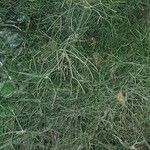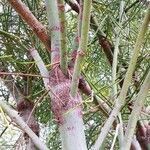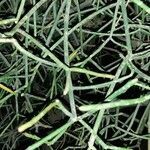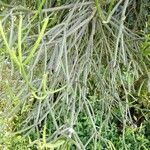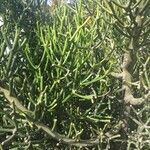Trees or shrubs, 2-6 m tall, dioecious, eventually forming trunk, 10-25 cm d.b.h.; bark rugose, gray or light. Stems green, succulent, very finely longitudinally striate. Leaves alternate, present only on new growth; stipules very small, caducous; petiole ± absent; leaf blade oblong-linear, 7-15 × 0.7-1.5 mm, base attenuate, margin entire, apex obtuse. Cyathia clustered at apex of branches, pedunculate, unisexual; involucral leaves minute, membranous, caducous; involucre turbinate, ca. 2 × 1.5 mm, shortly pubescent inside; glands 5, peltate-ovate or subrounded. Male flowers many, exserted from involucre. Female flower: ovary glabrous, exserted from involucre; styles connate below middle; stigma 2-lobed. Capsule 3-lobed, ca. 8 × 8 mm, smooth, sparsely pilose or glabrous. Seeds ovoid-globose, ca. 4 × 4 mm, smooth; caruncle small. Fl. and fr. Jul-Oct.
Cymes congested, 2–6 at the branchlet apices, each forking 2–4 times, with rays less than 1 mm long, producing a dense cluster of cyathia developing only male flowers, or occasionally a few female flowers also present, or cyathia fewer and only female flowers developing, the whole cyme ± glabrous, or tomentose with curled brown hairs especially on the involucres and lobes; bracts c. 2 × 1.5 mm, rounded, ± sharply keeled, usually glabrous except on the margin.
Spineless, densely branched, shrub or tree, up to 10 m high; branchlets 5-7 mm thick, finely striated, glabrous. Leaves fleshy, caducous, 8-15 mm long, linear-lanceolate, without stipules, subsessile. Cyathia clustered at tips of branches, sessile; finely felty; glands 5, entire. Flowering time Oct.-Dec. Capsule 8 mm in diam., obtusely 3-angled, finely puberulous, exserted for 8 mm; seeds with small white caruncle.
Female involucres: bracteoles present and occasionally also a few male flowers; female perianth distinctly 3-lobed below the tomentose ovary, with lobes 0.5 mm long; styles 2 mm long, joined at the base, with thickened deeply bifid recurved apices.
Branchlets brittle terete succulent, c. 7 mm thick, often produced in whorls, green with longitudinal fine striations and very small leaf scars, the extreme tips of young leafy branchlets sparsely tomentose with curled brown hairs.
A succulent shrub. It is branched and has an open crown. It does not have spines. It grows 2-6 m tall. The wood is moderately hard. The plant has an irritant white latex. There are only a few leaves.
Cyathia subsessile, c. 3 × 4 mm, with cup-shaped involucres; glands 5, 0.5 mm in diameter subcircular to 1.5 × 2 mm transversely elliptic, bright yellow; lobes c. 0.5 mm long, triangular.
Succulent tree, up to 9 m high. Branches alternate, opposite or in clusters. Leafy at apices of flowering shoots only. Leaves linear, 6.0-2.0 x 1.0-1.5 mm. Flowers yellowish green.
Leaves few, present only at the tips of young branchlets and quickly deciduous, subsessile; stipules glandular, minute, dark brown; lamina fleshy to 15 × 2 mm, linear-lanceolate.
Spineless succulent densely branched often apparently dioecious shrubs to 4 m or trees to 7 m high, with a copious irritant white to yellowish latex.
Male involucres: bracteoles linear with plumose apices; stamens 4.5 mm long; an aborted female flower is occasionally present.
Seeds 3.5 × 2.8 mm, ovoid, smooth, buff speckled with brown and with a dark brown ventral line; caruncle 1 mm across.
Capsule glabrescent, c. 8 × 8.5 mm, subglobose, exserted on a tomentose pedicel to 10 mm long.
